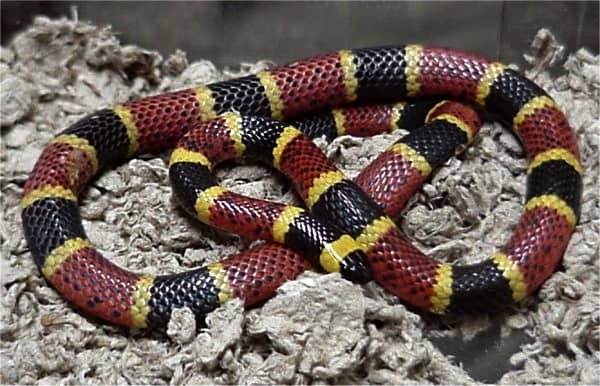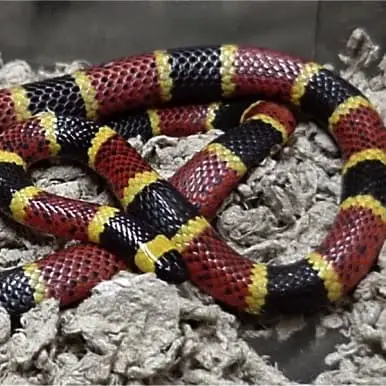The Texas coral snake is a highly venomous snake that can be found in the Southern United States and in Mexico. The thin snake with red, yellow and black crossbands is a close relative of the eastern coral snake.
Description
Texas coral snakes have very swmooth scales, giving it a shiny appearance. Their main characteristic are colorful black and red crossbands along their bodies, which are limited by a narrow yellow band on each side. The head and neck of the snake are black with a yellow band over the head.

How to distinguish between coral snake and scarlet snake and scarlet kingsnake?
Two nonvenomous snakes in the United States look very similar to the Texas coral snake and are often confused with it. The easiest way to distinguish nonvenomous snakes from the coral snake is the color of the head. Both the scarlet snake and the scarlet kingsnake have a red head while the coral snake has a black head and neck.
Red face, I’m safe
A great way to tell the venomous coral snake from other types.
Another identification mark is the distribution of colors of the snake. Also for this fact, several local sayings exist:
Red on yellow’s a deadly fellow; yellow on black’s a friendly Jack
If the red bands directly touch the yellow bands, you are looking at the venomous coral snake.
Size
Texas coral snakes are slightly larger than their close relatives, the eastern coral snake. Their body length including tail is around 24 inches (60 cm) on average. Generally, the male snake is smaller than the female snake.
Diet and Hunting Behavior
Coral snakes mainly feed on reptiles such as lizards and other snakes. They are also cannibalisity, meaning that they also prey on younger coral snakes. The coral snake is mostly nocturnal and is rarely seen hunting or even basking during the day. When hunting, the snake lies in ambush waiting for prey to pass by in striking distance. As soon as an interesting animal has entered that range, the snake strikes with a quick bite and usually holds on to the animal and digests it as a whole. The potent venom quickly immobilizes the prey.
Bite and Venom
The coral snake disposes of a highly toxic venom. Theoretically, an adult snake carries enough venom to kill five humans – but it cannot inject a large amount of venom with one bite. Since the snake mostly hunts for small prey, its jaws are not built to bite large animals or humans. Furthermore, due to its mainly nocturnal lifestyle, very few bites from coral snakes occur. According to various sources, around 100 people are bitten by eastern coral snakes per year. Around 40% of these bites are dry bites because the snake is unable to inject its venom when biting into large objects.
Bites are generally not fatal but immediate medical attention is absolutely necessary. A medical professional will administer an antivenom to counter the potentially life threatening effects of a coral snake bite. Symptoms of a bite are local pain and swellings as well as gastrointestinal disorders and paralysis. In extreme and untreated cases, death can occur within 24-26 hours due to respiratory paralysis. Since adult Texas coral snakes are generally larger than eastern coral snakes, they can be more dangerous to humans as they will more often succeed in injecting their venom into larger targets.
Habitat
The Texas coral snake has adapted to various habitats within its range. In Mexico, the snake can be found at elevations of up to 6,500 feet (2,000 m) above sea level as well as on low elevations. The snake can also be found in various vegetation zones but mostly in areas with a fertile ground. In the United States, it is often found in pine forests or mixed forests.
Texas coral snake range in the USA
The Texas coral snake can be found in the Southern United States as well as in Northern Mexico. It ranges through large parts of Southern and Eastern Texas, the southeastern tip of Oklahoma, Southeastern Arkansas and Eastern Louisiana.
Scientific classification of Micrurus fulvius
- Kingdom: Animalia
- Phylum: Chordata
- Class: Reptilia
- Order: Squamata
- Suborder: Serpentes
- Family: Elapidae
- Genus: Micrurus
- Species: Micrurus tener
Micrurus tener is subdivided into five subspecies. Mircrurus tener tener is the most common subsspecies and the only one found in the United States. The other four subspecies can be found only in Northern Mexico.
Other common names
In addition to Eastern coral snake, Micrurus fulvius is commonly known under these names: American cobra, (Elaps or Florida) harlequin snake, coral adder, candy-stick snake, harlequin coral snake, red bead snake, thunder-and-lightning snake.
